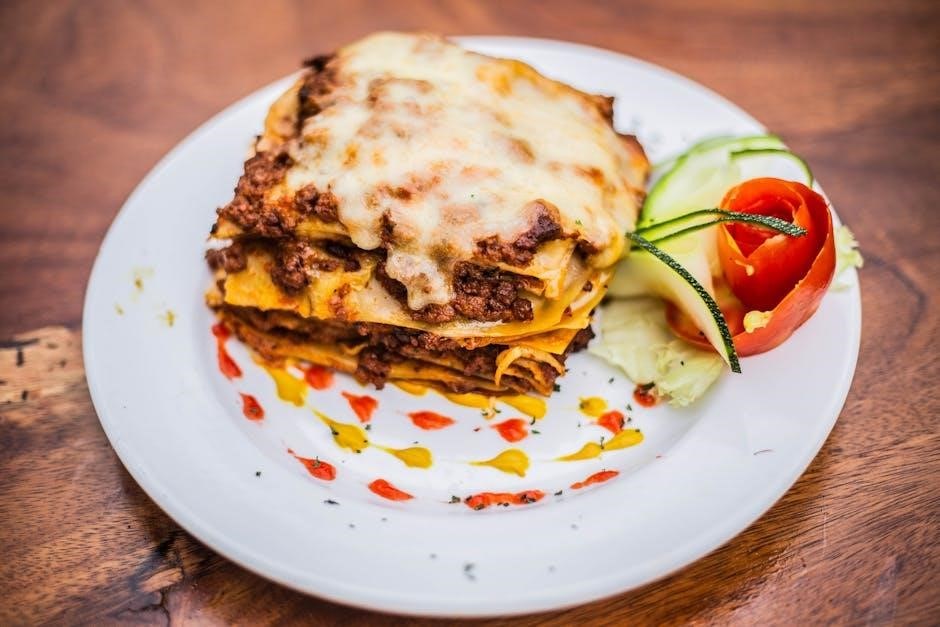Stouffer Lasagna is a beloved frozen meal offering layers of pasta, cheese, and sauce. This guide provides easy-to-follow instructions for oven and microwave cooking, ensuring a perfect dish every time.
Overview of Stouffer Lasagna
Stouffer Lasagna is a popular frozen meal known for its rich layers of pasta, cheese, and savory meat sauce. It offers a convenient and satisfying solution for busy households, providing a comforting, homemade taste without the effort of traditional cooking. The dish is designed to cater to both individual cravings and family-sized gatherings, making it a versatile option for various occasions. Stouffer Lasagna is widely admired for its flavorful ingredients and consistent quality, ensuring a delicious meal every time. Recent updates to the recipe reflect the brand’s commitment to simplifying and enhancing its products, aligning with consumer preferences for ease and taste. This beloved classic continues to be a staple in many kitchens, offering warmth and nourishment with minimal preparation.
Importance of Following Cooking Instructions
Adhering to the cooking instructions for Stouffer Lasagna is crucial for achieving the best results. Proper cooking ensures the lasagna reaches a safe internal temperature, eliminating the risk of foodborne illness. It also guarantees the pasta is tender, the cheese is melted evenly, and the flavors are fully developed. Deviating from the guidelines can lead to undercooked or overcooked sections, affecting texture and taste. Additionally, following the instructions helps prevent common issues like burning or a soggy finish. Whether using the oven or microwave, adhering to the recommended times and temperatures ensures a consistent, satisfying meal. This attention to detail enhances both the quality and safety of your dining experience.
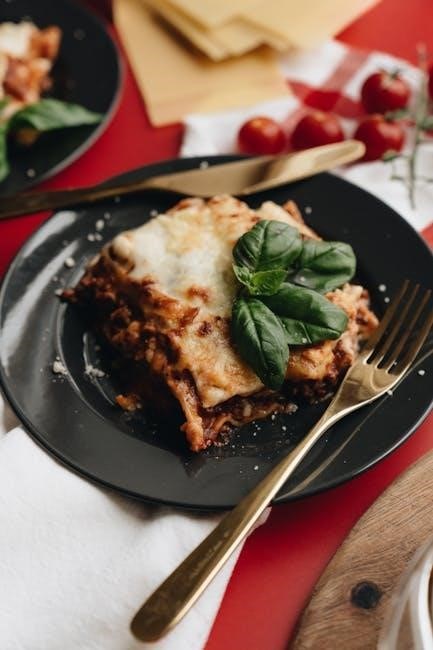
Cooking Methods for Stouffer Lasagna
Stouffer Lasagna offers versatile cooking options, including oven and microwave methods, catering to different preferences and time constraints while ensuring a delicious, evenly cooked meal every time.
Oven Cooking Instructions
Preheat your oven to 375°F (190°C). Place the Stouffer Lasagna on a baking sheet lined with aluminum foil or parchment paper to catch any drips. Remove the plastic wrap and cover the tray with aluminum foil. Bake for 60-70 minutes for a family-size lasagna, or until the internal temperature reaches 165°F (75°C). Remove the foil for the last 10-15 minutes to allow the top layer to brown. Let the lasagna rest for 10-15 minutes before slicing to ensure the cheese sets and the layers stay intact. This method ensures even heating and a crispy, golden-brown finish, delivering a flavorful and satisfying meal.
Microwave Cooking Instructions
For microwave cooking, vent the plastic wrap by poking a few holes or cutting a small slit. Cook on high for 3-4 minutes for single-serve portions or 8-10 minutes for family-size lasagna. Check if the lasagna is hot and bubbly around the edges; if not, cook in additional 30-second increments until cooked through. Let it stand for 1-2 minutes before serving. Use a microwave-safe dish if the tray isn’t suitable. Ensure the internal temperature reaches 165°F (75°C) for food safety. Be cautious when removing as it may be hot. This method provides a quick and convenient way to enjoy Stouffer Lasagna while maintaining its flavor and texture.
Conventional Oven vs. Microwave: Pros and Cons
Cooking Stouffer Lasagna in a conventional oven ensures even browning and a crispy top, which many prefer. It’s ideal for family-size portions and maintains texture. However, it requires preheating and takes longer (about 45-60 minutes). The microwave offers speed and convenience, cooking in 8-10 minutes for family size. It’s great for single servings and fits busy schedules. Yet, it risks uneven heating and a softer texture. The oven provides better results for larger portions, while the microwave is perfect for quick, smaller meals. Choose based on time and desired texture. Both methods deliver flavorful results when followed correctly.

Detailed Oven Cooking Guide
Preheat oven to 375°F (190°C). Place lasagna on a baking sheet, cover with foil, and bake for 45-60 minutes. Remove foil for last 10 minutes to brown. Ensure center is hot and bubbly. Let rest before serving.
Preheating the Oven
Preheating the oven to the correct temperature is essential for even cooking. Set your oven to 375°F (190°C) and allow it to preheat for at least 15-20 minutes. This ensures consistent heat distribution, which is crucial for cooking Stouffer lasagna evenly. A properly preheated oven helps the lasagna cook thoroughly, preventing undercooked or overcooked sections. Always check your oven’s temperature accuracy using an oven thermometer for best results. Preheating is a foundational step that sets the stage for a perfectly cooked meal. Neglecting this step can lead to uneven browning and texture issues. Make it a habit to preheat patiently for optimal outcomes.
Step-by-Step Oven Cooking Process
After preheating your oven to 375°F (190°C), carefully remove the Stouffer lasagna from its packaging. Place the lasagna on a baking sheet lined with aluminum foil or parchment paper to catch any drips. Cover the dish with aluminum foil to ensure even cooking and prevent the top from burning. Bake for 50-60 minutes for a family-size lasagna or 35-45 minutes for a smaller portion. Remove the foil for the last 10-15 minutes to allow the cheese to brown. Let the lasagna rest for 5-10 minutes before serving to allow the layers to set. This step-by-step process ensures a perfectly cooked, flavorful meal. Always refer to the package for specific size guidelines.
Cooking Time for Family Size Lasagna
The cooking time for a family size Stouffer lasagna in the oven is approximately 60-70 minutes at 375°F (190°C). Place the lasagna on a baking sheet and cover it with foil for the first 50 minutes to prevent over-browning. Remove the foil for the last 10-15 minutes to allow the cheese to brown evenly. If cooking from a thawed state, reduce the time by about 10-15 minutes; Ensure the internal temperature reaches 165°F (74°C) for food safety. Cooking times may vary slightly depending on oven performance, so check for a bubbly, golden-brown top. Always refer to the package instructions for precise guidelines.

Cooking Thawed vs. Frozen Lasagna
Cooking thawed and frozen Stouffer lasagna requires slightly different approaches. A thawed lasagna cooks more evenly and in less time, typically 50-60 minutes at 375°F (190°C). Frozen lasagna, however, needs about 70-75 minutes at the same temperature. Always cover the dish with foil for the first 50 minutes to prevent drying out. For thawed lasagna, remove the foil 10-15 minutes earlier to allow the top layer to brown. Frozen lasagna may need an additional 10 minutes uncovered to achieve the same result. Ensure the internal temperature reaches 165°F (74°C) for safety. Proper thawing overnight in the refrigerator is recommended for the best results.
Ensuring Even Browning and Crispness
To achieve even browning and crispness when cooking Stouffer lasagna, follow these tips. Begin by preheating the oven to the recommended temperature to ensure consistent heat distribution. Place the lasagna centrally on the middle rack to avoid hot spots. Covering the dish with foil for the first 50 minutes prevents excessive browning, then remove the foil for the final 10-15 minutes to allow the top layer to crisp up. For an extra crispy top, broil on high for 1-2 minutes after cooking. Let the lasagna rest for 5-10 minutes before serving to retain moisture and crispness. Avoid overcooking, as it can lead to a dry, over-browned texture.

Microwave Cooking Instructions
For microwave cooking, vent the plastic film to allow steam to escape. Cook on high for 3-4 minutes per serving. Ensure the center is steaming hot.
Preparation for Microwave Cooking
Before microwaving Stouffer lasagna, ensure the plastic film is vented to allow steam to escape. Place the lasagna on a microwave-safe plate or dish, centered to promote even cooking. Pierce the film if instructed or vent it by cutting a small slit. Avoid using metal utensils or containers, as they can cause sparks. If your microwave has a rotating turntable, position the lasagna evenly to ensure consistent heating. Make sure the microwave is set to high power. For frozen lasagna, follow the same steps; thawed lasagna may require slightly less cooking time. Always refer to the package instructions for specific preparation guidelines.
Step-by-Step Microwave Cooking Process
Cooking Stouffer lasagna in the microwave is quick and straightforward. Start by placing the vented lasagna on a microwave-safe dish. Cook on high for 3-4 minutes for a single serving or 8-10 minutes for a family size, depending on your microwave’s power. Rotate the dish halfway through cooking to ensure even heating. After cooking, let it stand for 1-2 minutes to allow the cheese to set and the heat to distribute evenly. Use oven mitts to remove the dish, as it will be hot. For best results, avoid overcooking, as this can dry out the lasagna. Always check the internal temperature to ensure it reaches a safe minimum of 165°F (74°C).
Cooking Time for Different Sizes
Cooking time for Stouffer lasagna in the microwave varies based on size. A single-serve portion typically takes 3-4 minutes, while a family-size lasagna requires 8-10 minutes on high. Adjustments may be needed depending on your microwave’s wattage, as power levels can range from 600 to 1200 watts. For smaller portions, reduce the time by 1-2 minutes to prevent overcooking. Always check the lasagna halfway through the recommended time to ensure even cooking. Use a food thermometer to confirm the internal temperature reaches 165°F (74°C) for food safety. Rotate the dish midway for consistent results. Avoid overheating, as it can dry out the pasta and cheese. Follow these guidelines for perfectly cooked Stouffer lasagna every time.
Standing Time After Cooking
Standing time is crucial after cooking Stouffer lasagna to ensure the best texture and flavor. For microwave-cooked lasagna, allow it to stand for 5 minutes before serving. This allows the cheese to set and the internal temperature to distribute evenly. For oven-cooked lasagna, let it rest for 10-15 minutes. Covering it with aluminum foil during standing can help retain moisture. Avoid skipping this step, as it prevents the lasagna from becoming runny or falling apart when sliced. The standing time also ensures food safety by allowing the lasagna to cool slightly, making it easier to handle. Patience during this step will result in a more enjoyable dining experience. Always let it stand to achieve the perfect consistency and flavor.
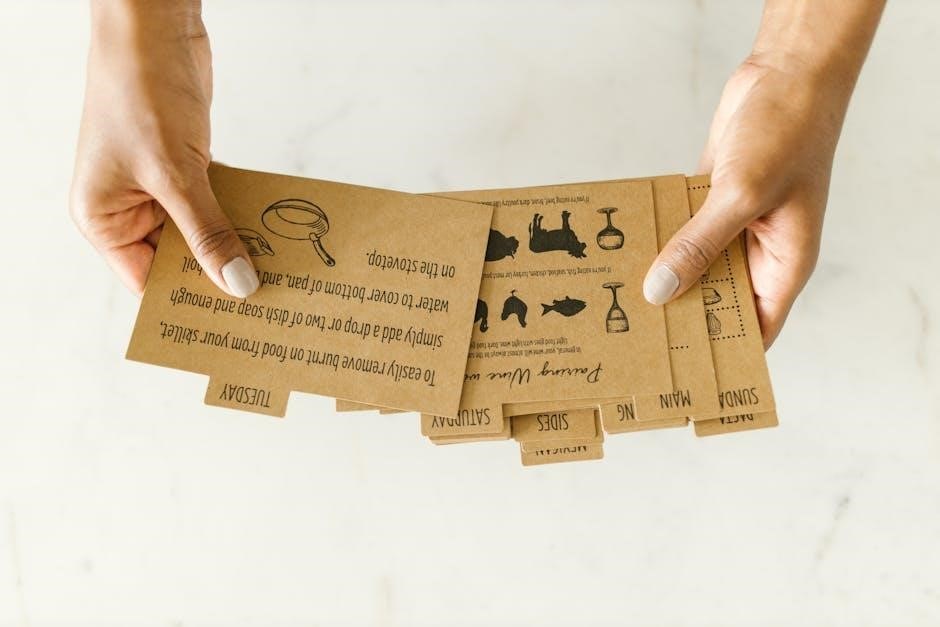
Food Safety and Quality
Ensuring food safety is vital for a quality dining experience. Always cook Stouffer lasagna to the recommended internal temperature of 165°F (74°C) to prevent foodborne illness. Proper handling and storage of both frozen and thawed lasagna are essential to maintain its quality and safety. Follow the package instructions for thawing and reheating to avoid contamination risks. Adhering to these guidelines ensures a safe and enjoyable meal every time. Prioritize safety to savor the perfect flavor and texture of Stouffer lasagna without compromise.
Internal Temperature Requirements
For food safety, Stouffer lasagna must reach an internal temperature of 165°F (74°C) when cooked. Use a food thermometer to check the center of the lasagna, ensuring accuracy. This temperature guarantees that all ingredients, including meat and cheese, are thoroughly cooked and safe to eat. Proper heating prevents undercooked areas that may harbor bacteria, reducing the risk of foodborne illness. Always prioritize this step, especially when cooking from frozen or thawed states. Even heating ensures consistency and safety, making your meal both enjoyable and secure. Never skip this critical step to maintain quality and safety standards.
Handling Frozen and Thawed Products
Stouffer lasagna can be stored frozen at 0°F (-18°C) for up to 8 months. When thawing, place the lasagna in the refrigerator overnight or thaw at room temperature for a few hours. Avoid refreezing thawed lasagna to maintain quality and texture. Always store thawed lasagna in the refrigerator and cook within 1-2 days. Proper handling prevents freezer burn and ensures freshness. If thawing in the microwave, cook immediately after thawing to avoid bacterial growth. Never leave thawed lasagna at room temperature for extended periods, as this can compromise food safety. Follow these guidelines to preserve the product’s taste and texture.
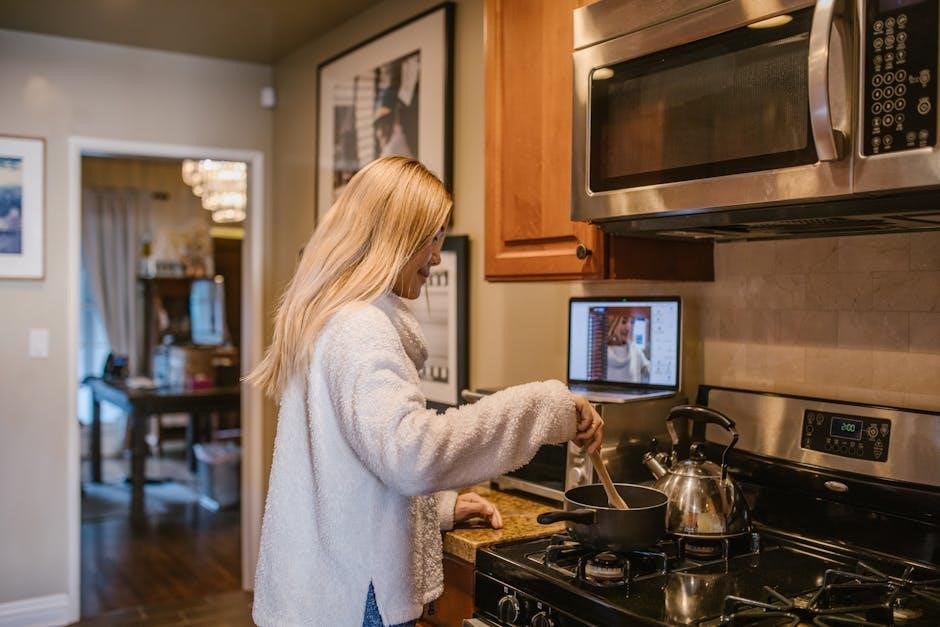
Importance of Following Safety Guidelines
Adhering to safety guidelines when cooking Stouffer lasagna is crucial for ensuring a safe and enjoyable dining experience. Proper food handling and cooking practices prevent foodborne illnesses, which can arise from undercooked or improperly stored products. Always cook the lasagna to the recommended internal temperature of 165°F (74°C) to eliminate harmful bacteria. Additionally, storing the product at appropriate temperatures—either frozen or refrigerated—maintains its quality and safety. Ignoring safety guidelines can lead to spoiled food, uneven cooking, or health risks. By following the instructions, you ensure the lasagna is prepared to the manufacturer’s standards, delivering the best taste and texture while safeguarding your health.
Product Information
Stouffer’s family-size lasagna offers a convenient meal solution with rich layers of pasta, flavorful sauce, and a blend of cheeses, providing essential nutrients and taste.
Stouffer Family Size Lasagna Details
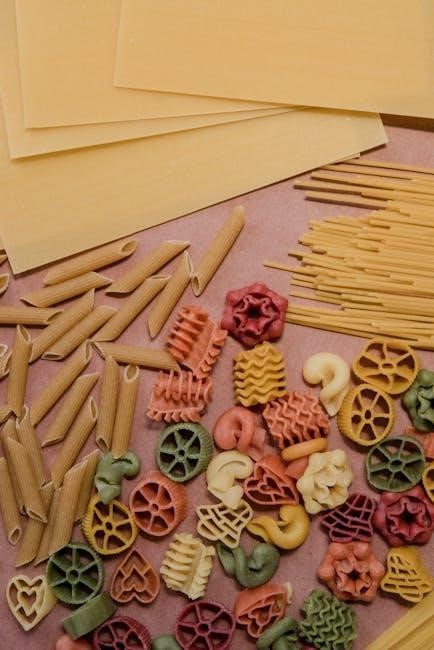
Stouffer’s family-size lasagna is a popular frozen meal designed to serve 4-6 people, offering a convenient and satisfying dining experience. Made with layers of pasta, rich meat sauce, and a creamy blend of cheeses, it provides a hearty and flavorful meal. The product is pre-assembled and frozen, requiring minimal preparation. Each serving contains essential nutrients, including protein, calcium, and iron, making it a balanced option for families. The lasagna is packaged in a single unit, perfect for baking in a conventional oven. Stouffer’s ensures high-quality ingredients and consistent taste, adhering to food safety standards. It’s widely available in supermarkets, making it an accessible choice for home cooking. Always store frozen until ready to cook for optimal freshness.
Ingredients and Nutritional Information
Stouffer’s family-size lasagna contains layers of pasta, ground beef, tomato sauce, and a blend of cheeses, including ricotta, mozzarella, and parmesan. The ingredients are carefully selected to ensure a balanced flavor and texture. A single serving (1 cup or 223g) provides approximately 350 calories, with 18g of fat, 25g of carbs, and 20g of protein. It is a good source of calcium and iron. The lasagna is gluten-free and contains no artificial flavors or colors. However, it may include allergens like milk and soy. Nutritional values may vary slightly depending on the specific product variant. Always check the packaging for the most accurate information.
Recent Changes in Cooking Instructions
Recent updates to Stouffer Lasagna cooking instructions include slight adjustments to oven temperatures and cooking times to enhance even browning and crispiness. The recommended oven temperature has been increased by 5 degrees Fahrenheit to ensure a golden-brown crust without overcooking. Additionally, Stouffer now advises covering the lasagna for the first 30 minutes to prevent drying out, then uncovering it for the last 10 minutes to crisp the top layer. These changes aim to simplify the cooking process and deliver a more consistent result. Consumers are encouraged to refer to the updated packaging or the official Stouffer website for the most current guidelines. This ensures that every batch meets the expected quality standards, providing a delicious and satisfying meal every time.
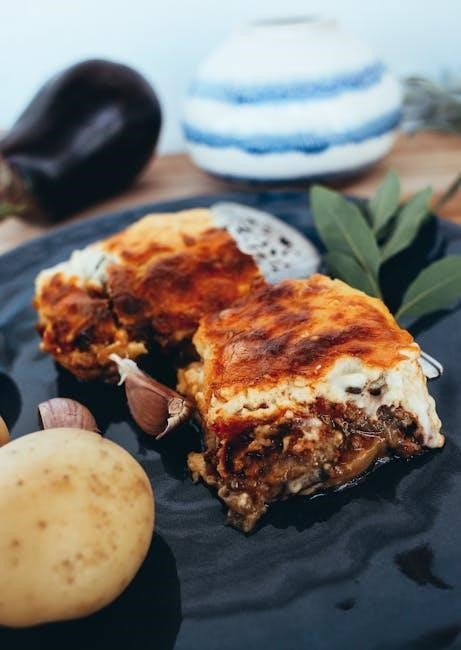
Common Mistakes to Avoid
- Overcooking or undercooking the lasagna, leading to uneven texture or dryness.
- Not using a baking sheet to catch overflow during oven cooking.
- Neglecting to vent the lasagna, causing steam buildup and sogginess.
Overcooking or Undercooking
Overcooking or undercooking Stouffer lasagna can significantly affect its quality and taste. Overcooking leads to a dry, hardened texture, while undercooking results in a soggy, unappetizing dish. To avoid these issues, strictly adhere to the recommended cooking times and temperatures provided on the packaging or in the instructions. For oven cooking, ensure the lasagna reaches an internal temperature of 165°F (74°C) for food safety. Use a food thermometer to check the center for accuracy. Additionally, avoid opening the oven too frequently, as this can disrupt even heating. If using a microwave, follow the specified cooking time for your lasagna size to prevent uneven cooking. Always let the lasagna stand for a few minutes after cooking to allow the flavors to settle and the texture to stabilize. Proper timing ensures a perfectly cooked, enjoyable meal.
Not Using a Baking Sheet
Not using a baking sheet when cooking Stouffer lasagna can lead to a messy cleanup and potential damage to your oven. The baking sheet acts as a protective layer, catching any cheese or sauce that might bubble over during cooking. Without it, drips can fall to the bottom of the oven, causing stubborn stains and unpleasant odors. Additionally, a baking sheet ensures proper air circulation around the lasagna, promoting even cooking. Stouffer recommends placing the lasagna on a baking sheet lined with aluminum foil or parchment paper for easy cleanup and to prevent direct contact with the oven rack. This simple step enhances both the cooking process and the overall quality of the final dish. Always prioritize using a baking sheet for a hassle-free experience.
Ignoring Venting Instructions
Ignoring venting instructions when cooking Stouffer lasagna can negatively impact the final result. Proper venting ensures that steam escapes, preventing the lasagna from becoming soggy or unevenly cooked. If the packaging is sealed too tightly, it can trap moisture, leading to a less crispy top and potentially undercooked layers. Stouffer recommends venting the lasagna by cutting slits in the plastic film or covering it loosely with foil to allow steam to escape. Failing to do so may result in a messy cleanup, as cheese and sauce might bubble over. Always follow the venting guidelines to achieve the perfect texture and flavor. This simple step ensures a balanced and satisfying dining experience.
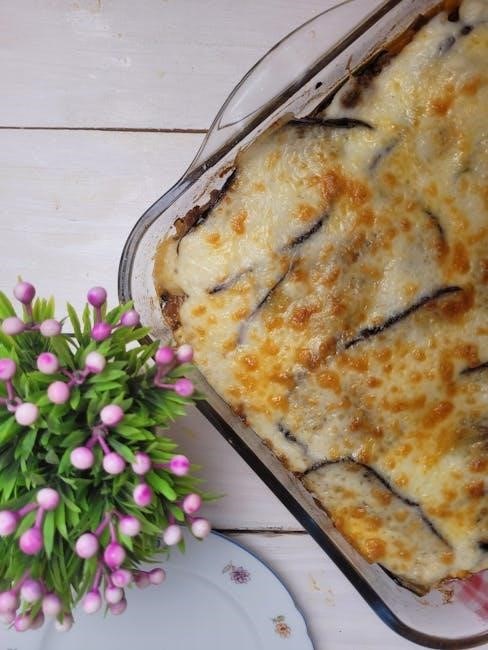
Advanced Cooking Tips
Elevate your Stouffer lasagna with these expert tips:
- Add fresh herbs like basil or oregano for extra flavor.
- Top with grated Parmesan before baking for a crispy finish.
- Serve with a side salad or garlic bread for a complete meal.
Customizing Stouffer Lasagna
Enhance your Stouffer lasagna by adding personal touches to suit your taste preferences.
- Add extra layers of cheese, such as ricotta or mozzarella, for creamier texture.
- Incorporate cooked ground beef or sausage for a meaty twist.
- Introduce sautéed spinach or mushrooms for added flavor and nutrients.
- Sprinkle garlic powder or Italian seasoning on top before baking.
- For a crispy top, broil for 1-2 minutes after cooking.
These customizations allow you to enjoy a personalized dish while maintaining the convenience of Stouffer’s pre-made lasagna.
Troubleshooting Cooking Issues
Encounter common cooking challenges? Here’s how to resolve them:
- Dry or overcooked edges: Cover the dish with foil to prevent overcooking and ensure even heating.
- Soggy texture: Avoid adding extra liquid; ensure the lasagna is cooked to the recommended internal temperature.
- Uneven browning: Rotate the dish halfway through cooking and use the middle rack for consistent results.
- Cheese not bubbling: Increase oven temperature by 10-15°F for the last 5 minutes of cooking.
These tips help achieve a perfectly cooked, flavorful Stouffer lasagna every time.
Using a Fan Oven: Adjustments and Tips
Cooking Stouffer lasagna in a fan oven requires minor adjustments for optimal results:
- Temperature reduction: Decrease the oven temperature by 20°F (10-15°C) to prevent overcooking.
- Cooking time: Reduce cooking time by 10-15 minutes due to faster air circulation.
- Positioning: Place the lasagna in the center rack to ensure even cooking.
- Covering: Cover with foil initially to avoid excessive browning, then remove for the last 10 minutes.
These adjustments ensure a perfectly cooked, evenly baked lasagna in a fan oven.
Thank you for following our guide to cooking Stouffer lasagna. By adhering to these steps, you’ll achieve a delicious, perfectly cooked meal every time. Enjoy!
Final Thoughts on Cooking Stouffer Lasagna
Cooking Stouffer lasagna is a straightforward process that yields a satisfying, flavorful meal. By following the provided instructions, you can ensure your lasagna is cooked to perfection. Whether you choose the oven or microwave method, the result is a delicious, cheesy dish that’s perfect for family dinners or quick meals. Remember to always prioritize food safety and use the recommended cooking times to avoid undercooking or overcooking. Experiment with custom toppings or sides to make the dish your own. Stouffer lasagna offers convenience without compromising on taste, making it a reliable option for any occasion. Enjoy your perfectly cooked lasagna!
Encouraging Experimentation and Enjoyment
Cooking Stouffer lasagna is not just about following instructions—it’s an opportunity to get creative and enjoy a satisfying meal. While the classic recipe is delicious on its own, feel free to add your personal touch. Try topping it with fresh herbs, a sprinkle of Parmesan cheese, or a side of garlic bread for added flavor. Experimenting with sides, such as a green salad or roasted vegetables, can elevate the dining experience. Remember, the key to enjoying Stouffer lasagna is to make it your own while appreciating its convenience and flavor. Whether you’re cooking for one or a family, it’s a dish that brings people together and satisfies cravings. Happy cooking!
